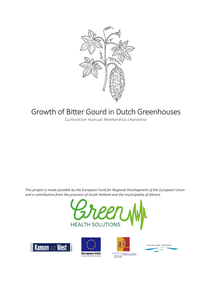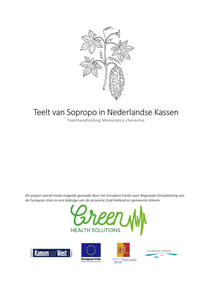In November 2019, the High Performance Greenhouse project (HiPerGreen) was nominated for the RAAK Award 2019, as one of the best applied research projects in the Netherlands. This paper discusses the challenges faced, lessons learned and critical factors in making the project into a success.
DOCUMENT

This paper describes the concept of a new algorithm to control an Unmanned Aerial System (UAS) for accurate autonomous indoor flight. Inside a greenhouse, Global Positioning System (GPS) signals are not reliable and not accurate enough. As an alternative, Ultra Wide Band (UWB) is used for localization. The noise is compensated by combining the UWB with the delta position signal from a novel optical flow algorithm through a Kalman Filter (KF). The end result is an accurate and stable position signal with low noise and low drift.
DOCUMENT

Bitter gourd is also called sopropo, balsam-pear, karela or bitter melon and is a member of the cucumber family (Cucurbitaceae). It is a monoecious, annual, fast-growing and herbaceous creeping plant. The wrinkled fruit of the bitter gourd is consumed as a vegetable and medicine in Asia, East Africa, South America and India. The aim of this bitter gourd cultivation manual is to make this cultivation accessible to Dutch growers and in this way be able to meet market demand. In addition, this cultivation manual aims to provide insight into the standardized production of the medicinal ingredients in the fruit.
DOCUMENT

Sopropo wordt ook wel bitter gourd, balsempeer, karela of bittermeloen genoemd en is lid van de komkommerfamilie (Cucurbitaceae). Het is een eenhuizige, eenjarige, snelgroeiende en kruidachtige klimplant. De gerimpelde vrucht van de bitter gourd wordt in Azië, Oost-Afrika, Zuid-Amerika en India geconsumeerd als groente en medicijn. Alhoewel de sopropo nog niet bekend is in de Nederlandse keuken, kan dit zeker een aanwinst zijn in de huidige trend om voeding te gebruiken als medicijn. Het doel van deze teelthandleiding van sopropo is het toegankelijk maken van deze teelt voor Nederlandse telers en op deze wijze te kunnen voldoen aan de marktvraag. Daarnaast heeft deze teelthandleiding als doel inzicht te geven in de gestandaardiseerde productie van de medicinale inhoudsstoffen in de vrucht.
DOCUMENT

The general aim of this research project has been to examine this phenomenon of tourism flow switching and consider the factors driving the geopolitical instability that can compromise destination security. On a more practical level the research has also examined what the reactions of Dutch tourists are to security threats affecting their tourism decisions and looked at the development of preventive measures against attacks by destinations and travel organisations. Finally, the research on the regional geopolitics of the MENA and European areas have together with the attitudes of Dutch tourists towards destination security been used as inputs into a scenario planning process involving the steering group of tour operators who originally commissioned this research, as participants. This process has focussed on macro environmental analysis, identification of key uncertainties, and the development of resilient strategies for the future.
DOCUMENT

The first part of this paper provides a series of conceptual critiques to illustrate how the recent move to inaugurate a “post-nature” world works to vindicate anthropocentric perspectives and a techno-managerial approach to the environmental crisis. We contend with this premise and suggest that troubling nature has profound implications for education. In the second part, we provide case studies from nature-based programs in The Netherlands and Canada to demonstrate how anthropocentric thinking can be reinscribed even as we work towards “sustainability”. Despite the tenacity of human hubris and the advent of the Anthropocene, we suggest these troubled times are also rich with emerging “post-anthropocentric” perspectives and practices. As such we offer “rewilding” as a means to think about education that moves beyond the romantic vestiges of “Nature” without lapsing into delusions of human exceptionalism. http://dx.doi.org/10.13135/2384-8677/2334 https://www.linkedin.com/in/helenkopnina/
MULTIFILE

This study theorizes on the sociomateriality of food in authority-building processes of partial organizations by exploring alternative food networks (AFNs). Through the construction of arenas for food provisioning, AFNs represent grassroots collectives that deliberately differentiate their practices from mainstream forms of food provisioning. Based on a sequential mixed-methods analysis of 24 AFNs, where an inductive chronological analysis is followed by a qualitative comparative analysis (QCA), we found that the entanglements between participants’ food provisioning practices and food itself shape how authority emerges in AFNs. Food generates biological, physiological and social struggles for AFN participants who, in turn, respond by embracing or avoiding them. As an outcome, most AFNs tend to bureaucratize over time according to four identified patterns while a few idiosyncratically build a more shared basis of authority. We conclude that the sociomateriality of food plays an important yet indirect role in understanding why and how food provisioning arenas re-organize and forge their forms of authority over time. Pascucci, S., Dentoni, D., Clements, J., Poldner, K., & Gartner, W. B. (2021). Forging Forms of Authority through the Sociomateriality of Food in Partial Organizations. Organization Studies, 42(2), 301-326. https://doi.org/10.1177/0170840620980232
DOCUMENT

In large organizations, innovation activities often take place in separate departments, centers, or studios. These departments aim to produce prototypes of solutions to the problems of operational business owners. However, too often these concepts remain in the prototype stage: they are never implemented and fall into what is popularly termed the Valley of Death. A design approach to innovation is presented as a solution to the problem. However, practice shows that teams that use design nevertheless encounter implementation challenges due to the larger infrastructure of the organization they are part of. This research aims to explore which organizational factors contribute to the Valley of Death during design innovation. An embedded multiple case study at a large heritage airline is applied. Four projects are analyzed to identify implementation challenges. A thematic data analysis reveals organizational design, departmental silos, and dissimilar innovation strategies contribute to the formation of, and encounters with, the Valley of Death. Arising resource-assignment challenges that result from these factors are also identified. Materialization, user-centeredness, and holistic problem framing are identified as design practices that mitigate encounters with the Valley of Death, thus leading to projects being fully realized. https://doi.org/10.1111/dmj.12052 LinkedIn: https://www.linkedin.com/in/christine-de-lille-8039372/
MULTIFILE

Our mission is to increase the productivity of Dutch greenhouses. Even the most modern greenhouses still suffer from 10% to 25% loss of crop due to pests and diseases (Pimentel, 2012). Our autonomous flying platform can reduce crop loss by regular scouting while avoiding excessive cost of manual labour. With one drone we can scout one hectare of greenhouse per hour, providing detailed information about environmental parameters and crop health, quality and quantity. In comparison traditional manual scouting methods scout a single hectare per day. As a spin-off from RAAK.MKB006.017 HiPerGreen, we are aiming for a fast track solution to a single pest control problem: Fusarium in orchids, and validate a Minimum Viable Product for use in the Greenhouse.
Biodiversity preservation is often viewed in utilitarian terms that render non-human species as ecosystem services or natural resources. The economic capture approach may be inadequate in addressing biodiversity loss because extinction of some species could conceivably come to pass without jeopardizing the survival of the humans. People might be materially sustained by a technological biora made to yield services and products required for human life. The failure to address biodiversity loss calls for an exploration of alternative paradigms. It is proposed that the failure to address biodiversity loss stems from the fact that ecocentric value holders are politically marginalized and underrepresented in the most powerful strata of society. While anthropocentric concerns with environment and private expressions of biophilia are acceptable in the wider society, the more pronounced publicly expressed deep ecology position is discouraged. “Radical environmentalists” are among the least understood of all contemporary opposition movements, not only in tactical terms, but also ethically. The article argues in favor of the inclusion of deep ecology perspective as an alternative to the current anthropocentric paradigm. https://doi.org/10.1080/1943815X.2012.742914 https://www.linkedin.com/in/helenkopnina/
DOCUMENT
